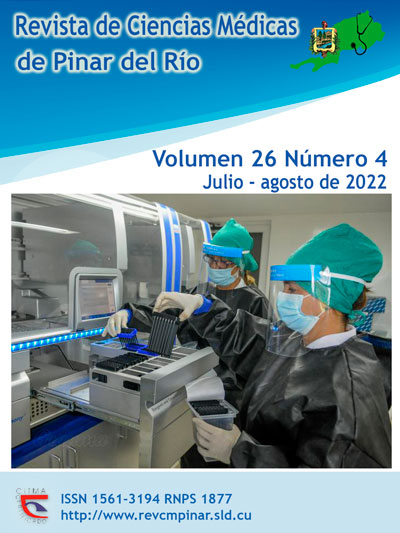C1-2 transarticular screw fixation combined with Gallie technique in atloaxial dislocation
Keywords:
TOOTH AVULSION, ATLANTO-AXIAL JOINT, VERTEBRAL ARTERY, DISLOCATION.Abstract
Introduction: Multiple surgical techniques exist to treat instability of the atlantoaxial complex. Transarticular C1-2 screw fixation (Magerl's technique) has shown high fusion rates, and can be combined with the initially described wiring systems to guarantee greater stability to the construct.
Case presentation: male, 62 years old, who after a two-meter fall, was brought to the institution reporting cervical pain and inability to move the limbs. On neurological examination, he had a grade B on the American Spinal Injury Classiffication Scale. A comminuted odontoid fracture and atloaxial dislocation were diagnosed. Cervical traction was applied and vertebral alignment was achieved. Surgical treatment was planned using Magerl's technique. Given the suboptimal trajectory of the initial screw, it was combined with posterior atloaxoid fusion, using Gallie technique. External immobilization was maintained for two weeks. At hospital discharge, the patient achieved ambulation, maintaining brachial dysparesis with distal predominance. In evolutionary radiological studies, no failure of the instrumentation system was observed.
Conclusions: In our case, the use of the Gallie technique, in view of the malposition of one of the C1-2 transarticular screws, allowed preserving the stability of the construct.
Downloads
References
1. Fiester P, Rao D, Soule E, Orallo P, Rahmathulla G. Anatomic, functional, and radiographic review of the ligaments of the craniocervical junction. J Craniovertebral Junction Spine [Internet]. 2021 [citado 17/6/2021]; 12(1): 4-9. Disponible en: https://www.ncbi.nlm.nih.gov/pmc/articles/PMC8035576/
2. Fiedler N, Spiegl UJA, Jarvers J-S, Josten C, Heyde CE, Osterhoff G. Epidemiology and management of atlas fractures. Eur Spine J [Internet]. 1 de octubre de 2020 [citado 17/6/2021]; 29(10): 2477-83. Disponible en: https://doi.org/10.1007/s00586-020-06317-7
3. Du HG, Thanh DX, Phuoc VX, Hoang ND, Tan LD, Trung NV. Comparison of two techniques for the treatment for atlantoaxial instability injury: C1–C2 transarticular screws and C1 lateral mass–C2 pedicle screws [Internet]. In Review; 2020 jul [citado 02/04/2021]. Disponible en: https://www.researchsquare.com/article/rs-39689/v1
4. Joaquim AF, Mudo ML, Tan LA, Riew KD. Posterior Subaxial Cervical Spine Screw Fixation: A Review of Techniques. Glob Spine J [Internet]. 1 de octubre de 2018 [citado 17/6/2021]; 8(7): 751-60. Disponible en: https://www.ncbi.nlm.nih.gov/pmc/articles/PMC6232718/
5. Chen Q, Brahimaj BC, Khanna R, Kerolus MG, Tan LA, David BT, et al. Posterior atlantoaxial fusion: a comprehensive review of surgical techniques and relevant vascular anomalies. J Spine Surg [Internet]. 2020 [citado 02/04/2021]; 6(1): 164-80. Disponible en: https://www.ncbi.nlm.nih.gov/pmc/articles/PMC7154353/
6. Wang X, Wang H, Chen G, et al. The Long-term Clinical Outcomes of Magerl's Technique Combined with Single Laminar Clamp Internal Fixation in Treatment of Reducible Atlantoaxial Dislocation. Research Square [Internet]. 2020 [citado 02/04/2021]. Disponible en: https://europepmc.org/article/ppr/ppr124883
7. Kulkarni DSK, Rathod DAK, Nayak DA, Raina DV, Gupta DNR. Comparative analysis of clinical outcomes of surgically stabilised atlanto-axial instability with various surgical methods. Int J Orthop Sci [Internet]. 2021 [citado 17/6/2021]; 7(2): 575-82. Disponible en: https://www.orthopaper.com/archives/?year=2021&vol=7&issue=2&ArticleId=2678
8. Saro A, Abdelhameid AK, Fadl KN. Surgical outcome of type II odontoid fracture, Harms technique. Egypt J Neurosurg [Internet]. 23 de enero de 2019 [citado 17/6/2021]; 34(1): 3. Disponible en: https://doi.org/10.1186/s41984-019-0031-1
9. Lvov I, Grin A, Talypov A, Barbakadze Z, Abdrafiev R, Krylov V. Fluoroscopic landmarks and trajectories for safe posterior percutaneous transarticular C1–C2 screw insertion: a CT-based simulation study. Eur Spine J [Internet]. 31 de enero de 2021 [citado 17/6/2021]; 30(6):1651-1661. Disponible en: https://pubmed.ncbi.nlm.nih.gov/33517498/
10. Magklara E-P, Pantelia E-T, Solia E, Panagouli E, Piagkou M, Mazarakis A, et al. Vertebral artery variations revised: origin, course, branches and embryonic development. Folia Morphol [Internet]. 2021 [citado 17/6/2021]; 80(1):1-12. Disponible en: https://journals.viamedica.pl/folia_morphologica/article/view/FM.a2020.0022
11. Goel A, Rangnekar R, Shah A, Rai S, Vutha R. Mobilization of the Vertebral Artery—Surgical Option for C2 Screw Fixation in Cases With “High Riding” Vertebral Artery. Oper Neurosurg [Internet]. 1 de junio de 2020 [citado 17/6/2021]; 18(6): 648-51. Disponible en: https://doi.org/10.1093/ons/opz289
12. Pavlov O, Mirchev N, Behr R. A possible novel technique for intraoperative imaging of the vertebral artery during arthrodesis of the upper cervical spine. Med Hypotheses [Internet]. 1 de julio de 2020 [citado 17/6/2021]; 140:109641. Disponible en: https://www.sciencedirect.com/science/article/pii/S0306987720301511
13. Karakoyun DO. Clinical Results of Harms Technique in Atlantoaxial Instability Treatment. Middle Black Sea J Health Sci [Internet]. 31 de diciembre de 2020 [citado 17/6/2021]; 6(3): 294-8. Disponible en: https://dergipark.org.tr/en/pub/mbsjohs/771475
14. Tamayo EEH, Marrero A, Hernández EAG, González LCA. Fijación transaxial odontoidea combinada con fusión atlantoaxial posterior por técnica de Gallie modificada en fractura odontoidea tipo II [Internet]. 2021 [citado 17/6/2021]; 35(3). Disponible en: http://www.revortopedia.sld.cu/index.php/revortopedia/article/view/204
Downloads
Published
How to Cite
Issue
Section
License
Authors who have publications with this journal agree to the following terms: Authors will retain their copyrights and grant the journal the right of first publication of their work, which will be publication of their work, which will be simultaneously subject to the Creative Commons Attribution License (CC-BY-NC 4.0) that allows third parties to share the work as long as its author and first publication in this journal are indicated.
Authors may adopt other non-exclusive license agreements for distribution of the published version of the work (e.g.: deposit it in an institutional telematic archive or publish it in a volume). Likewise, and according to the recommendations of the Medical Sciences Editorial (ECIMED), authors must declare in each article their contribution according to the CRediT taxonomy (contributor roles). This taxonomy includes 14 roles, which can be used to represent the tasks typically performed by contributors in scientific academic production. It should be consulted in monograph) whenever initial publication in this journal is indicated. Authors are allowed and encouraged to disseminate their work through the Internet (e.g., in institutional telematic archives or on their web page) before and during the submission process, which may produce interesting exchanges and increase citations of the published work. (See The effect of open access). https://casrai.org/credit/



